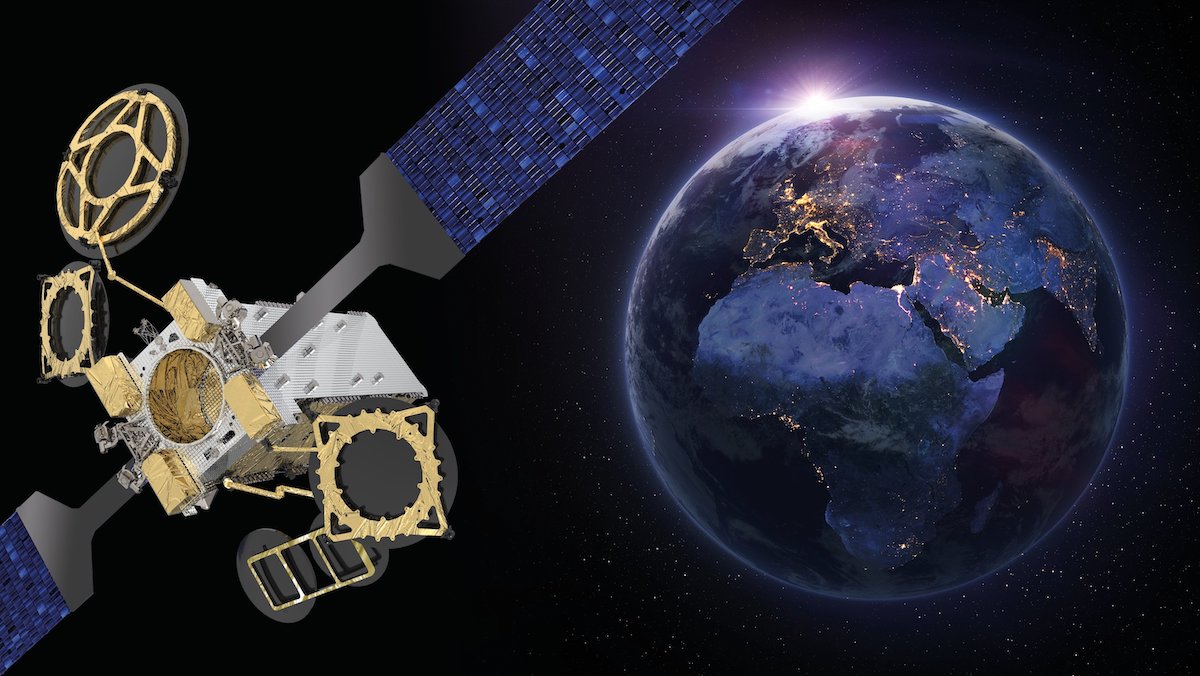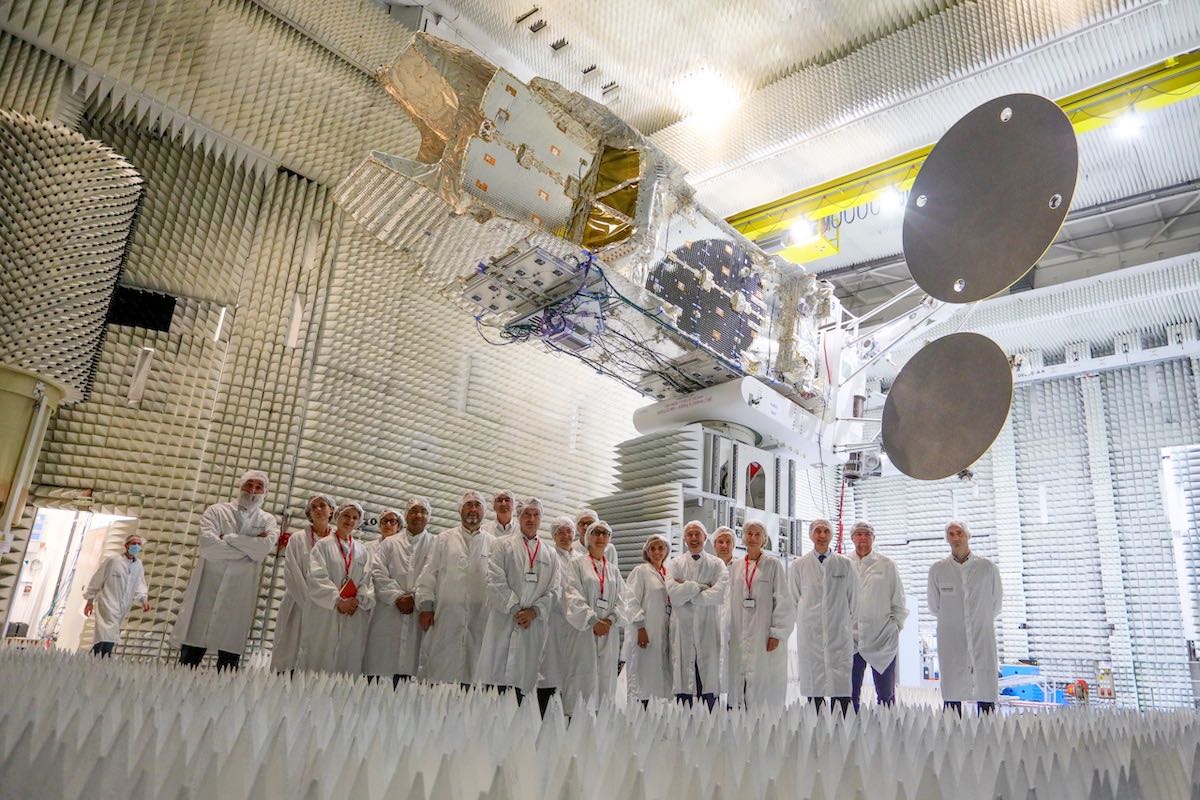Live coverage of the countdown and launch of a SpaceX Falcon 9 rocket from Space Launch Complex 40 at Cape Canaveral Space Force Station, Florida. The Falcon 9 rocket launched the Eutelsat 10B broadband communications satellite for aviation and maritime connectivity. Follow us on Twitter.
SFN Live
SpaceX’s oldest active Falcon 9 rocket booster, in service since 2018, made its final flight Tuesday night to deliver a Eutelsat broadband communications satellite into orbit on a mission to provide internet services to airplanes and ships across the North Atlantic, Europe, the Middle East, and Africa. The mission completed a series of four major satellite launches for Eutelsat since early September.
The Eutelsat 10B satellite lifted off on top of a Falcon 9 rocket at 9:57 p.m. EST Tuesday (0257 GMT Wednesday) from pad 40 at Cape Canaveral Space Force Station in Florida. Eutelsat 10B is heading toward a perch in geostationary orbit to beam communications signals across a coverage zone from the North Atlantic to Asia, employing more than 100 spot beams to connect airline and cruise ship passengers, maritime crews, and other users on-the-go.
A launch attempt Monday night was scrubbed a couple of hours before liftoff to “allow for additional pre-flight checkouts,” SpaceX said. And SpaceX defied the odds Tuesday night after forecasters predicted a 90% chance of unacceptable weather conditions for launch.
SpaceX did not attempt to recover the first stage of the 229-foot-tall (70-meter) Falcon 9 rocket. The launch company had an agreement with Eutelsat to dedicate all of the Falcon 9’s lift capability to sending the Eutelsat 10B satellite into as high of an orbit as possible, without reserving and propellant on the first stage for landing maneuvers.
A few miles north of pad 40, SpaceX intended to launch a Falcon 9 rocket earlier Tuesday to begin a cargo resupply mission to the International Space Station. But bad weather prevented liftoff of that flight from Kennedy Space Center, delaying the mission until Saturday.
Eutelsat 10B deployed from the Falcon 9 rocket’s upper stage about 35 minutes after launch. The rocket aimed to release the spacecraft into a “super synchronous” transfer orbit with an apogee, or farthest point from Earth, well above Eutelsat 10B’s final operating altitude of 22,000 miles (nearly 36,000 kilometers). The target apogee for the Eutelsat 10B mission at spacecraft deployment was above 37,000 miles, or about 60,000 kilometers, according to Pascal Homsy, Eutelsat’s chief technical officer.
Instead of reserving some of its propellant for landing on a drone ship, the Falcon 9’s first stage booster burned its nine main engines a few seconds longer than usual, giving an extra burst of speed to the rocket’s upper stage. That allowed the Falcon 9’s second stage engine to place the Eutelsat 10B satellite into a higher orbit than would have otherwise been possible.
SpaceX still planned to retrieve the two halves of the Falcon 9 rocket’s payload fairing for refurbishment and reuse.

A spokesperson for Thales Alenia Space, the manufacturer of Eutelsat 10B, said the deployment of the satellite into a super synchronous transfer orbit will shorten the time needed for it to reach its final operational geostationary orbit by about 10 days. Based on Thales’ Spacebus Neo satellite platform, Eutelsat 10B will use plasma thrusters for the orbit adjustments needed to circularize its orbit at geostationary altitude 22,000 miles over the equator, where it will circle Earth in lock-step with the planet’s rotation.
Eutelsat 10B’s total launch mass is about 5.5 metric tons, or roughly 12,000 pounds, a Thales spokesperson told Spaceflight Now on Monday.
The expendable Falcon 9 mission marked the third time this month that SpaceX has disposed of a Falcon rocket booster, following the intentional disposals of a core stage on a Falcon Heavy rocket Nov. 1 and a Falcon 9 booster on a mission Nov. 12. The Nov. 12 mission lofted two communications satellites for Intelsat, which said it paid a premium for the extra performance from the Falcon 9, resulting in the booster’s disposal in the Atlantic Ocean.
“The reason why Eutelsat choose an expendable booster for this mission is because of the mass of the satellite, which requires the full capacity of fuel and extra performance of the Falcon 9 rocket and a proper orbit injection,” Homsy told Spaceflight Now in response to written questions.
Homsy declined to say how much, if anything, Eutelsat paid SpaceX for the additional performance from the Falcon 9 on the Eutelsat 10B mission.
Once in geostationary orbit next year, Eutelsat 10B will steer itself to an operating position along the equator at 10 degrees east longitude. The satellite will add capacity for internet connectivity services for airplanes and ships across the highly-trafficked North Atlantic corridor between Europe and North America. Eutelsat 10B will also provide similar services over Europe, the Mediterranean basin, and the Middle East, according to Eutelsat, the satellites Paris-based owner and operator.
Eutelsat 10B carries two multi-beam high-throughout Ku-band payloads for aviation and maritime internet services. These two payloads have 116 spot beams capable of processing more than 50 GHz of bandwidth, and offering a throughout of approximately 35 gigabits per second, Eutelsat said.
The satellite also hosts two wide beam C-band and Ku-band payloads to extend services currently provided by the aging Eutelsat 10A satellite, which launched in 2009.
Eutelsat 10B is scheduled to enter service in the summer of 2023, Homsy said.

The launch of Eutelsat 10B also marked the fourth large Eutelsat communications satellite to launch in the last two-and-a-half months, beginning with the Eutelsat Konnect VHTS satellite which launched in September on an Ariane 5 rocket. Two Hotbird TV broadcasting satellites joined Eutelsat’s fleet after launches from Florida on Falcon 9 rockets in October and earlier this month.
“Quite a challenge for the Eutelsat engineering teams, who have been up to the challenge,” Homsy said.
During Tuesday night’s countdown, the Falcon 9 launcher was filled with a million pounds of kerosene and liquid oxygen propellants in the final 35 minutes before liftoff.
After teams verified technical and weather parameters were all “green” for launch, the nine Merlin 1D main engines on the first stage booster flashed to life with the help of an ignition fluid called triethylaluminum/triethylborane, or TEA-TEB. Once the engines ramped up to full throttle, hydraulic clamps opened to release the Falcon 9 for its climb into space.
The nine main engines produced 1.7 million pounds of thrust for more than two-and-a-half minutes, propelling the Falcon 9 and Eutelsat 10B into the upper atmosphere. Then the booster stage shut down and separated from the Falcon 9’s upper stage to begin an uncontrolled fall into the Atlantic.
The booster was not fitted with SpaceX’s recovery hardware, such as titanium grid fins or landing legs. And SpaceX did not deploy one of its drone ships for the expendable mission.
A SpaceX recovery ship was on station to recover the Falcon 9 rocket’s payload fairing after the nose cone’s two clamshell halves parachuted into the sea downrange from Cape Canaveral. The payload fairing jettisoned from the rocket about three-and-a-half minutes into the flight, shortly after ignition of the Falcon 9’s upper stage engine.
The Falcon 9 rocket fired its upper stage engine two times to inject the Eutelsat 10B spacecraft into an elliptical super synchronous transfer orbit, then the satellite deployed from the rocket. Eutelsat 10B will unfurl its solar panels and begin maneuvers with an on-board electrical propulsion system to circularize its orbit at geostationary altitude around 22,000 miles over the equator.
ROCKET: Falcon 9 (B1049.11)
PAYLOAD: Eutelsat 10B communications satellite
LAUNCH SITE: SLC-40, Cape Canaveral Space Force Station, Florida
LAUNCH DATE: Nov. 22, 2022
LAUNCH TIME: 9:57 p.m. EST (0257 GMT on Nov. 23)
WEATHER FORECAST: 10% probability of acceptable weather
BOOSTER RECOVERY: None
LAUNCH AZIMUTH: East
TARGET ORBIT: Super synchronous transfer orbit
LAUNCH TIMELINE:
-
- T+00:00: Liftoff
- T+01:16: Maximum aerodynamic pressure (Max-Q)
- T+02:43: First stage main engine cutoff (MECO)
- T+02:47: Stage separation
- T+02:54: Second stage engine ignition
- T+03:36: Fairing jettison
- T+08:05: Second stage engine cutoff (SECO 1)
- T+26:18: Second stage engine restart
- T+27:27: Second stage engine cutoff (SECO 2)
- T+35:28: Eutelsat 10B separation
MISSION STATS:
- 186th launch of a Falcon 9 rocket since 2010
- 195th launch of Falcon rocket family since 2006
- 11th launch of Falcon 9 booster B1049
- 159th Falcon 9 launch from Florida’s Space Coast
- 104th Falcon 9 launch from pad 40
- 159th launch overall from pad 40
- 127th flight of a reused Falcon 9 booster
- 5th SpaceX launch for Eutelsat
- 52nd Falcon 9 launch of 2022
- 53rd launch by SpaceX in 2022
- 51st orbital launch attempt based out of Cape Canaveral in 2022
Email the author.
Follow Stephen Clark on Twitter: @StephenClark1.
